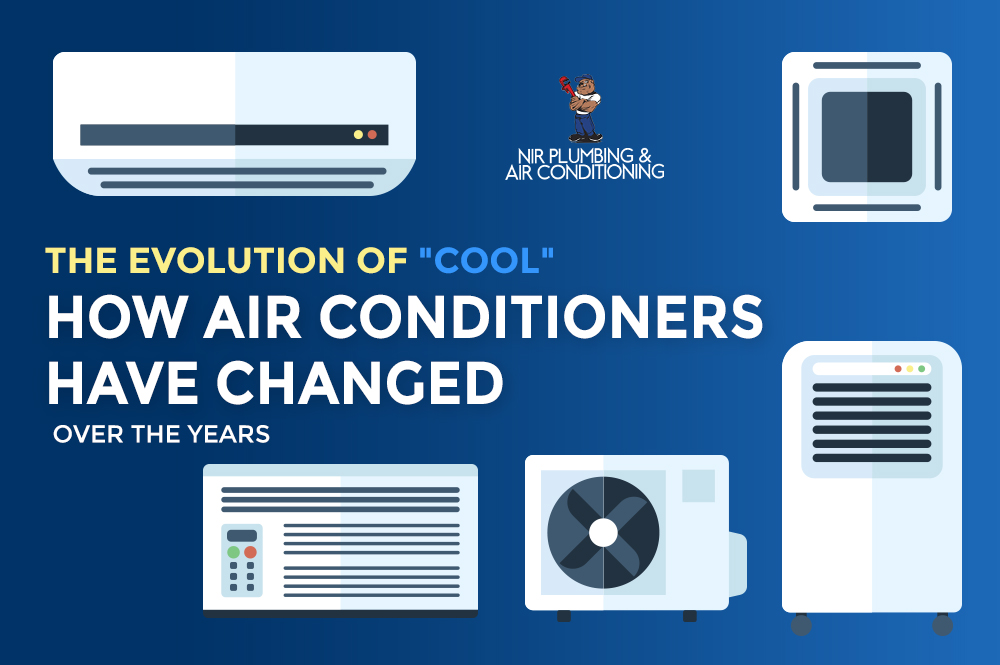Overview: Unique changes in air conditioner units over the years (yes, you can cool your home without actually being home.
All hail the evolution of air conditioners! There’s no doubt that we’ve been grateful to have air conditioners for over a century. Once considered a luxury, domestic air conditioning meant that traditional architectural features — wide eaves, deep porches, thick walls, high ceilings, attics, and cross ventilation — were no longer needed to promote natural cooling.
From safety standards to new technology, the HVAC industry today looks dramatically different than it did just a few decades ago, that’s why continuing education is required for HVAC technicians. So, let’s dive into the details:
-
History of the first air conditioner units (and its predecessor: the refrigerator)
-
Timeline of the evolution of the air conditioner in the 1970s and on
-
Refrigerants, the environment, and upgrades
-
Affordability & size
-
Enhanced performance improvements
This invention is now essential, allowing us to cool homes, businesses, hospitals, data centers, laboratories and other buildings vital to our economy and daily lives.
Related article(s): The History of Air Conditioning and How It Changed America
Where it all started: The beginnings of the first A/C unit
-
The first A/C unit was developed — or should we say “successfully demonstrated” — in 1848 by Dr. John Gorrie of Florida.
-
As a physician, Gorrie proposed the idea of cooling cities to relieve residents of “the evils of high temperatures.”
-
He believed that cooling was the key to avoiding diseases like malaria and making patients more comfortable. Obviously, this belief wasn’t true and, additionally, his rudimentary system for cooling hospital rooms required ice to be shipped to Florida from frozen lakes and streams in the northern United States.
-
This was an expensive logistical challenge so instead, Gorrie began experimenting with the concept of artificial cooling.
-
-
Gorrie designed an ice machine that created ice using a compressor powered by horse, water, win-driven sails, or steam that was granted the U.S. patent in 1851.
-
Although Gorrie was unsuccessful at bringing his patented technology to the marketplace primarily due to the death of his chief financial backer, his invention laid the foundation for modern air conditioning and refrigeration.
-
-
Nearly 50 years later (1902) Willis Carrier designed what we would call the first “modern” electrical air conditioning unit (the one for the publishing company we mentioned it).
-
The invention was designed to control humidity more than temperature. Cold air can hold less moisture than warm; Carrier’s invention helped keep humidity levels low for the Sackett & Wilhelms printing plant, where moisture was wreaking havoc on the paper and ink.
-
His solution was brilliantly simple: by circulating chilled water instead of hot water through a heater’s coils, Carrier was able to chill the air that passed over it.
-
Though early air conditioners were large and expensive, the technology behind their operation is essentially the same as what we rely on today.
-
-
The refrigerator provided the model for early residential air conditioners. As consumer interest grew in the late 1920’s, refrigerator manufacturers were among the first to develop air conditioners due to their technical expertise with small-scale refrigeration units, automatic controls as well as mass-production.
Related article(s): History of Air Conditioning
A quick timeline of major air conditioner changes in the 1970s and on
1970s:
-
Ductless air conditioning systems are first invented. They’re offered as an alternative to standard portable air conditioners, which usually attach to windows. The new system allows air conditioners to be located in places other than windows, including ceilings and walls. Although they don’t gain widespread use in the U.S. for a few years, they’re critical for the adoption of air conditioning in densely populated cities in Asia.
-
New inventions by Exxon reduce the cost of solar production from $100 per Watt to $20 per Watt. The lower cost means that solar power becomes a viable power source for a variety of applications, including HVAC.
-
1975:
-
National standards for appliances are first adopted.
-
-
1978:
-
An air-to-air heat pump design is invented at the Oak Ridge National Laboratory, allowing for significant improvements in air conditioners.
-
-
1987:
-
The United Nations Montreal Protocol is established to protect the ozone layer.
-
Ozone depleting chemicals are to be phased out. At this point, most air conditioners use a coolant called Freon.
-
SEER (Seasonal Energy Efficiency Ratio) 10 is adopted as the measure of energy efficiency for HVAC systems. It’s the first national standard for HVAC energy efficiency.
1994:
-
Freon is linked to ozone depletion, leading to its ban in many countries.
-
Search for more environmentally friendly coolants.
-
Carrier introduces a chlorine free HVAC system with no ozone depleting chemicals. It’s introduced two years earlier than other environmentally friendly models.
2000s/2010s
-
R410a replaces other coolants as the most environmentally friendly coolant on the market.
-
In 2011, Nest introduces the Nest Thermostat, making it easy to connect home HVAC systems to the Internet. Other startups, as well as utility companies, follow suit. Consumers can now monitor their energy usage and adjust their HVAC systems directly from their phones. It’s success leads to a $3.2 billion acquisition by Google just a few years later.
2020s:
-
HVAC technologies such as solar solutions and geothermal heat pumps are becoming more cost-effective options.
-
Eco-friendly buildings are being designed to use minimal energy to heat and cool the property.
-
Software programs help project the best energy- and cost-efficient systems for a given space.
Related article(s): 5 New HVAC Technology & Innovations Changing the Industry in 2020
How refrigerants have been used and recent changes
When cool water wasn’t available for early air conditioning systems, people used various refrigerants instead.
-
Refrigerants are used to convert between liquid and gaseous states, absorbing and dispelling heat in the process.
-
Contained in a closed loop, refrigerant can efficiently move heat from one area to another as it’s either compressed or evaporated.
-
For many years, people preferred R22 refrigerant for their air conditioning systems. However, they later discovered that this substance was doing irreparable damage to the ozone layer.
-
Since January 1, 2020, the substance became illegal.
-
New systems now rely on the more environmentally friendly R410A refrigerant.
-
Related article(s): The Evolution Of The Modern Air Conditioner
Air conditioner sizing, affordability, and efficiency
-
The size of air conditioners changed, too. At first, the venting and piping that was required for an air conditioner to function took up large rooms. As more efficient coolants were used, air conditioning systems shrank considerably.
-
Individual room air conditioners, which set the design for today’s portable air conditioners, were invented in 1931. These units sat on a window ledge, much like today’s window units. Although people could purchase them by 1932, they weren’t yet widely adopted.
-
A window unit cost between $10,000 and $50,000, or between $120,000 and $600,000 in today’s currency. Air conditioning was a luxury only the wealthy could afford.
-
By the 1950s, air conditioners are both affordable and widely available.
-
Air conditioner improvements that enhance performance and comfort
-
Greater energy efficiency
Did you know that as much as 50% of the energy consumed in your home is used by your HVAC system? Today’s new HVAC systems are easily twice as efficient as your old system.
Simply upgrading to a system with a higher SEER rating will noticeably reduce your electric bill. Today’s most efficient systems have SEER ratings between 14 and 23. According to the U.S. Environmental Protection Agency (EPA), every dollar invested in HVAC energy efficiency can produce a double or triple return on investment.
-
Better controls (including humidity)
Today’s new programmable thermostats give you precise control over the comfort levels in your home. Sophisticated models allow different settings for each day of the week to accommodate varying schedules, and provide precision displays and security features that prevent unauthorized occupants from changing the settings.
You can also take advantage of new models that can be controlled by phone or with Wifi apps. Also known as Smart Thermostats, you can control these models via your smart phone, tablet or laptop computer to avoid wasting energy heating and cooling an empty home. You can also turn on the AC when you’re headed home so you don’t have to walk into a sauna. Some can even automatically adjust the set temperature when you’re away.
-
Reduced noise
Tired of your loud air conditioner keeping you up at night? Getting the right size unit for your space, choosing the right brand for quietest operation, and choosing the right locations for your system’s air handlers can make all the difference between a comfortable night’s sleep and having to resort to earplugs.
-
Air purification
When it comes to removing dangerous microorganisms from the air you breathe, standard HVAC filters don’t really do the job. Those filters are designed to protect the equipment from damage, not to protect your lungs, eyes and skin from airborne pollutants.
Air conditioner improvements like central air purification systems can help. These systems remove dust, mold, smog, bacteria and viruses from the air circulated throughout your home’s HVAC system. They remove pollutants and microorganisms with a combination of heavy-duty HEPA filters that trap the larger particles like dust, and electrostatic fields that capture the tiniest particles like viruses.
Related article(s): Top 6 Air Conditioner Improvements NYC Homeowners Want


